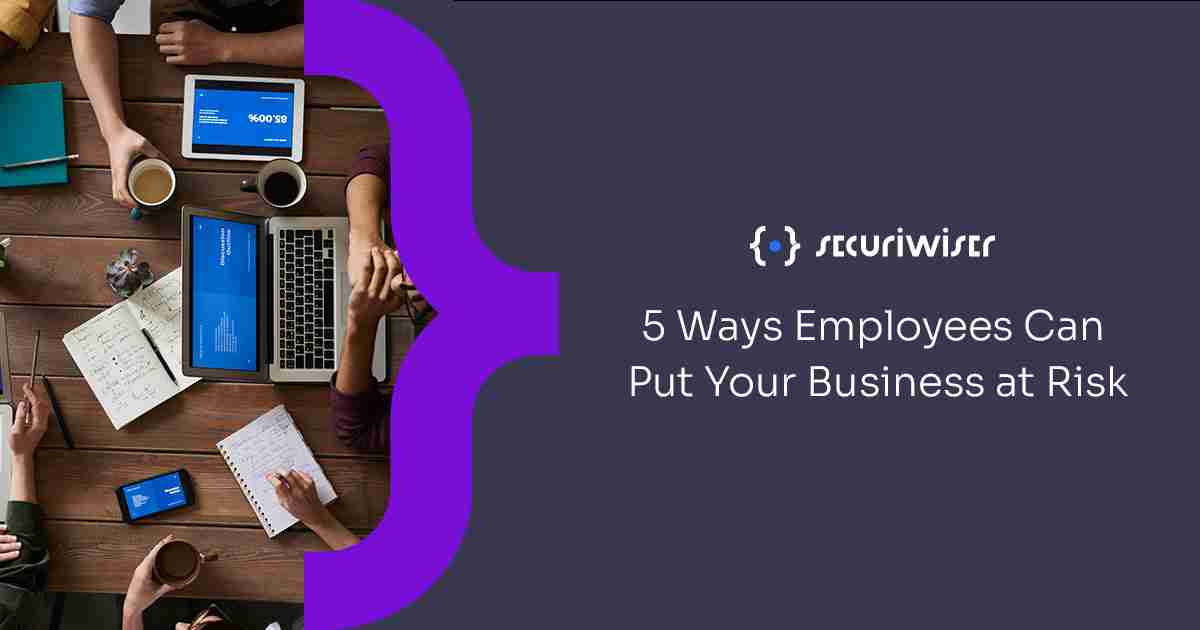5 Ways Employees Can Put Your Business at Risk
Blog / 5 Ways Employees Can Put Your Business at Risk
3 MIN READ


What is cybersecurity and how can employees affect my business?
In the current climate, almost all businesses have developed some form of online presence in an attempt to stay relevant, connected and in touch with their customer’s demands.
However, for many businesses which are new to cyberspace, one term can seem daunting and unapproachable – cybersecurity. What steps can be taken to mitigate cyber threats, deter hacking constructs and ensure that setting up an online presence does not result in a cyber-attack?
With more and more people accessing business assets remotely as a result of working from home post pandemic, one of the biggest security vulnerabilities of recent times is one of the least technical: careless employees.
Untrained, unskilled or simply careless employees can result in major cybersecurity vulnerabilities that can exploited by malicious third parties. Whether falling prey to phishing scams or downloading unsafe software on company devices, here are 5 ways employees can put your business at risk and what can be done to prevent it:
1. Phishing – clicking unsafe links
Perhaps the most common way for a hacker to gain unauthorized access to company assets is via a phishing scam.
From smaller scale nuisance cyber attacks to ransomware attacks that have taken down entire government frameworks such as the HSE attack in Ireland in May 2021, phishing remains one of the most predominant hacking constructs.
Simply put, an employee tasked with managing emails receives what they believe to be a legitimate link to something. However, when the bogus link is clicked, malware can be installed remotely and the device is compromised.
The main threat mitigation in this instance sounds simple but as shown by the multitude of attacks the stemmed from phishing, it is imperative that all employees are educated on the risks. All employees that have access to company data or the internet from a company network should be educated that clicking unauthorized links without checking what they are first is a serious security risk.
2. Using company devices to surf the web
The more an employee surfs the web, or strays from the safety of their delegated tasks online, the greater the risk of falling prey to a phishing scam.
Moreover, typically the more inappropriate the site, the more hidden adverts and fake links that can be used to download malware. A 2015 Blue Coat Study shows that one in ten employees watches porn at work – something that can not only impact a business’ integrity but also their cybersecurity.
Heavy sanctions should be in place to deter employees from surfing the web, be it social media or adult websites, and they should be educated on the risks of doing so from company devices.
3. Accessing company data/assets from personal devices
Whilst the post pandemic shift to allow for remote working has revolutionized the workplace for many businesses, it does not come without new and real cybersecurity threats.
In an office setting it is less likely to be a problem, but with so many people having taken their work home, many are slipping into the false sense of security that their devices cannot be compromised, and as such are accessing company data from personal devices.
This poses a major security threat as whilst company devices should be routinely updated with the latest malware protection software, personal devices are often not.
Subsequently, if an employee decides to access sensitive information and does not know that their home desktop is already infected with malware or more likely to be, the data in question is being put at risk.
Employee login locations should be monitored by the IT department, and all employees made aware of company policy that forbids access to work assets from personal devices.
4. Installing unauthorized software on company devices
As tempting as it might be to download seemingly innocuous applications that serve to streamline online experience, for instance AdBlocker, this can pose a risk to businesses online.
Much like phishing scams which allow hackers to remotely download malware to a company device and therefore access its’ assets, outright downloading things that are not authorized by the company is very dangerous and can easily infect a device.
Policies should be in place to ban employees from downloading any third-party software on company devices and sanctions handed out to those who knowingly put the business at risk.
5. Passwords
With so many websites that everyone has a login for nowadays, many people fall into the trap of using the same password for everything. This is not only a security risk for individuals, but can also pose a threat to businesses if employees use the same for work and personal life.
Passwords should be confidential amongst all employees and if a business uses a password no employees should use the same one for any personal logins.
Passwords should be routinely updated and changed to prevent leaks, and records of every employee’s login detail should be known the IT department or CEO.
Securiwiser can help your business stay safe in the cyber world via its daily monitoring of cyber threats, including those raised in this article. Start your free trial today by clicking here.
Previous Article
Why Your Company Can’t Survive Without Incident ResponseNext Article
The Role of Encryption in Data ProtectionHow secure is
your business?
Blog categories
How secure is
your business?